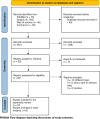Exploring the association between statins use or HMG-CoA reductase inhibition and migraine: a systematic review and meta-analysis
- PMID: 39901103
- PMCID: PMC11792188
- DOI: 10.1186/s10194-025-01957-w
Exploring the association between statins use or HMG-CoA reductase inhibition and migraine: a systematic review and meta-analysis
Abstract
Background: Statins or 3‑hydroxy‑3‑methyl‑glutarylcoenzyme A (HMG‑CoA) reductase inhibitors are medications that act by reducing the cholesterol content of liver cells Moreover, statins have been found to improve endothelial function and reduce vascular wall inflammation. A growing body of research suggests that statins are associated with less risk of migraine, and they can be used to treat symptoms. However, the evidence has been inconclusive, so we aim to investigate the nature and strength of the effect of statins on the prevention and prophylaxis of migraines.
Methods: We conducted a comprehensive systematic search across multiple electronic databases, including PubMed, Scopus, Web of Science, and the Cochrane Library, from inception until October 2024, to include studies on the association between statins use and migraine. The outcomes of interest involved the association of the HMG-CoA reductase gene with the risk of migraine, as well as the association and efficacy of statins in migraine patients.
Results: Thirteen studies were included in our systematic review. Mendelian Randomization (MR) studies revealed that expression of HMGCR was associated with an increased risk of migraine with odds ratio (OR) ranging from 1.38 to 1.55 (P < 0.001). Three observational studies investigating the relationship between statins and migraine risk demonstrated a protective effect, with odds ratios ranging from 0.73 to 0.94 (P < 0.001). The findings suggest a significant reduction in overall migraine risk, particularly for migraines with aura and in patients with higher vitamin D levels. Meta-analysis of randomized controlled trials (RCTs) showed that statins significantly reduced monthly migraine frequency (MD= -3.16, 95%CI= [-5.79, -0.53]; p = 0.02, I2 = 79%; P = 0.03). RCTs supported the efficacy of statins in reducing migraine frequency, days, and intensity compared to placebo.
Conclusions: Statins, already well-established for cardiovascular benefits, emerge as a promising dual-purpose therapy for many neurological disorders. The association between the HMGCR gene and increased migraine risk, coupled with the possible efficacy of statins in reducing migraine frequency, may open new avenues for migraine prophylaxis. However, the variability in study design hinders definitive conclusions, so larger studies with longer follow-ups are required to ascertain both findings.
Keywords: HMG-CoA reductase; Mendelian randomization study; Meta-analysis; Migraine; Monthly migraine frequency; Statins.
© 2025. The Author(s).
Conflict of interest statement
Declarations. Competing interests: The authors declare no competing interests. Ethics approval and consent to participate: Not applicable. Consent for publication: Not applicable.
Figures
References
-
- Stovner L, Hagen K, Jensen R, et al (2007) The Global Burden of Headache: A Documentation of Headache Prevalence and Disability Worldwide. Cephalalgia 27:193–210. 10.1111/j.1468-2982.2007.01288.x. - PubMed
-
- Lima AM, Sapienza GB, Giraud VO, Fragoso YD (2011) Odors as triggering and worsening factors for migraine in men. Arq Neuropsiquiatr 69:324–327. 10.1590/S0004-282X2011000300011. - PubMed
-
- Vos T, Abajobir AA, Abate KH, et al (2017) Global, regional, and national incidence, prevalence, and years lived with disability for 328 diseases and injuries for 195 countries, 1990–2016: a systematic analysis for the Global Burden of Disease Study 2016. The Lancet 390:1211–1259. 10.1016/S0140-6736(17)32154-2. - PMC - PubMed
-
- Stewart WF, Linet MS, Celentano DD, et al (1991) Age- and Sex-specific Incidence Rates of Migraine with and without Visual Aura. Am J Epidemiol 134:1111–1120. 10.1093/oxfordjournals.aje.a116014. - PubMed
-
- Evers S, Áfra J, Frese A, et al (2009) EFNS guideline on the drug treatment of migraine– revised report of an EFNS task force. Eur J Neurol 16:968–981. 10.1111/j.1468-1331.2009.02748.x. - PubMed
Publication types
MeSH terms
Substances
LinkOut - more resources
Full Text Sources
Medical
Miscellaneous




